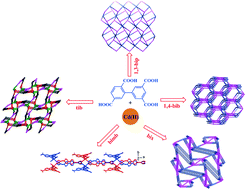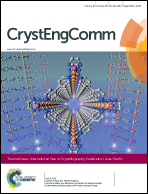Five Cd(ii) coordination polymers based on 2,3′,5,5′-biphenyltetracarboxylic acid and N-donor coligands: syntheses, structures and fluorescent properties†
Abstract
Five Cd(II) coordination polymers, {[Cd2(Hbptc)2(H2O)2]·(1,3-H2bip)}n (1), [Cd2(bptc)(1,4-bib) (H2O)2]n (2), {[Cd2(bptc)(bix)(H2O)2]·3H2O}n (3), [Cd(H2bptc)(bimb)(H2O)]n (4) and [Cd2(bptc)(tib)(H2O)]n (5), where H4bptc = 2,3′,5,5′-biphenyltetracarboxylic acid, 1,3-bip = 1,3-bis(imidazole)propane, 1,4-bib = 1,4-bis(imidazole)butane, bix = 1,4-bis(imidazol-1-ylmethyl) benzene, bimb = 4,4′-bis(imidazol-1-ylmethyl)biphenyl and tib = 1,3,5-tris(imidazol-1-yl)benzene, have been synthesized using Cd(II) acetate with H4bptc and different bis(imidazole) ligands under hydrothermal conditions. Their structures have been characterized using elemental analysis, IR spectroscopy, single-crystal X-ray crystallography and powder X-ray diffraction (PXRD) analysis. Complex 1 displays a (3,6)-connected CdI2 topology, which further forms a 3D supramolecular framework by O–H⋯O hydrogen bonding interactions. Complex 2 features a 3D network with a (4,5,7)-connected (3·43·52)(3·43·52·63·7)(3·46·54·68·72) topology. Complex 3 exhibits a 3D framework with a (3,4,5)-connected (5·6·7)(4·52·6·7·8)(4·52·62·73·82) topology. Complex 4 has a 2-fold interpenetrated (4,4) net. Complex 5 possesses a 3D self-penetrating network with two dia nets. The results show that H4bptc can act as a versatile building block for the construction of various metal–organic frameworks (MOFs). Moreover, the fluorescent properties of 1–5 in the solid state have been investigated.

- This article is part of the themed collection: International Year of Crystallography Celebration: Asia-Pacific

 Please wait while we load your content...
Please wait while we load your content...